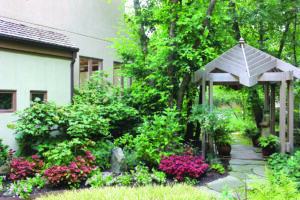
Feng shui holds that chi, a positive energy circulates through all living things and the way things a placed in a space can either facilitate or stifle the flow of chi. (Photo by Sean Clougherty)
Feng shui, the ancient Chinese art of placement, gets a lot of attention inside a living space when arranging furniture, choosing paint colors and decluttering.
But its principles are just as applicable outside the home, says Sara Danenmann, owner of Wind & Water and a certified Interior Alignment feng shui practitioner.
Feng Shui is the practice of working with elements of a particular space to try to enhance your life by bringing it into harmony and balance with its surroundings.
Feng shui holds that chi, a positive energy, circulates through all living things and the way things are placed in a space can either facilitate or stifle the flow of chi.
“You want to keep chi in an area,” Danenmann said. “You don’t want it to rush through, you want it to meander. We want chi to stay but not stop.”
That often translates to winding paths of natural stone or curved flower beds rather than hard corners and long straight stretches. Wind chimes and reflective surfaces are other tools to enhance the flow of chi.
In consultations, Danenmann employs the Baqua, an energy map that guides placement of elements.
Octagon in shape, the map lays out physical elements like metal, wood, earth and water and their corresponding colors, across from each other to bring balance in design.
So, water and blue and black elements are positioned to the north, across from fire and red elements to the south; big earth elements across from small earth and wood across from metal.
The symbolism, position and nature of the elements have been translated into energetic signatures that correspond with areas of a person’s life.
The order, and positioning, of the elements are transitional, moving from one energetic state to the next one.
“It’s all about how you feel,” Danenmann said. “So much of what makes this work is how you feel in that space.”
Danenmann became interested in feng shui as her husband was recovering from a heart attack.
“I turned to my faith, family and friends and did a lot of reading,” she said. “Somewhere I came across an article about the ancient art of feng shui. I had nothing to lose and everything to gain, so I started making some of the recommended adjustments.”
She took the practice further recently by graduating from Denise Linn’s Interior Alignment/ Instinctive Feng Shui certification program, a three-month course with an immersive seven-day on-site training in Pennsylvania.
Danenmann said when working with a client, she first wants them to take time to observe their space paying attention to how what they see makes them feel.
“That little bit plays so much on our psyche, so a lot of what I do is get people to stop and feel their space,” she said. “We’ve gotten away from that with all of our artificial distractions.”
Editing out what hinders chi is crucial before beginning to place new elements or rearrange existing elements.
“If you look at something everyday that you hate, it doesn’t make you feel good,” she said.
For large items, including the position of a home, Danenmann uses the concept of the “armchair position.”
The sturdy back of the chair can be a forested area, hill, or anything that brings an energy of protection to the space.
The armrests at the side of the chair offer protection but are lower and allow for chi to move and give peripheral visibility.
This can be a split-rail fence, a few trees or a friendly neighbor.
The front should stay open, with an expansive view and inviting flow of chi.
She recalled one of her early uses of feng shui was putting in a small waterfall feature in a koi pond by the main entrance of the home.
Initially, she said they faced it toward the driveway, “for all to see” but after some time, that proved to be incorrect.
“I learned that the waterfall must face the home so that the flow goes into the house,” she said. “Quickly, we put the waterfall on the other side of the pond with the flow into our house instead of facing away.”
While the concept originated in a foreign country and a lot of facets that fall under the overall feng shui umbrella, Danenmann said for clients, she likes to simplify the process as much as possible, ultimately focusing on the feelings evoked by an element’s placement.
She said it’s important to honor each person’s uniqueness, supporting the goals they have for the space.
“I don’t want to complicate it. If you complicate it, people get turned off and it’s too much to absorb.” Danenmann said. “When you feel good you have good chi. The flow is good.”





